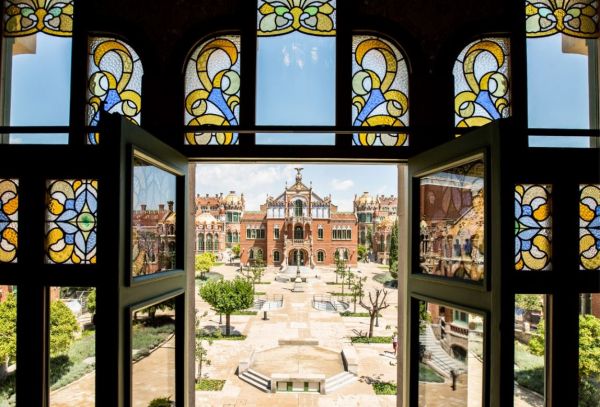The excursion will show you the country's hospital heritage which includes some beautiful and well-conserved buildings, some of which are medieval in origin, while others represent the essence of
Modernisme. All of them have changed their use. Nevertheless, the excursion is also a homage to the health sector in the present context of the global pandemic. We start with the
Modernista premises of the Hospital de Sant Pau (1). The guided visits reveal how Lluís Domènech i Montaner worked to put architecture, art and engineering at the service of health.
BARCELONA He had assimilated the principles of hygiene, as propounded by doctors during the first half of the 20th century concerned about the lack of salubrity and hygiene in the industrial cities and who promoted the regulation of standards for such things as housing, the supply of clean drinking water, lighting, and sewage systems. For the first time, environmental factors for the improvement of health were taken into account. An image today that would illustrate what this revolution meant would be that of a patient with Covid-19 being transferred in a hospital bed by health staff to overlook the Passeig Marítim in Barceloneta so that they can see the sea. But let's return to the
Modernista premises of the Hospital de Sant Pau, consisting of pavilions, and gardens in which to stroll and enjoy the sunshine, built during the early years of the 20th century because the
Hospital de la Santa Creu (2) had become too small.
This former hospital still exists and is now the magnificent
Biblioteca de Catalunya. Visits are organised for groups but there is no restriction on entering the vestibule from where you can admire its majestic Gothic nave. During the middle ages medicine had a distinctly ecclesiastical character given that knowledge was in the hands of the monasteries. However, the founding of lay schools, such as the one in Salerno, and universities such as the ones in Montpeller and Pàdua, led to great advances, as did the translation of Greek and Arabic medical treatises
GIRONA
Barcelona is not the only major city in Catalonia to have what was a medieval hospital. Girona has the former
Hospital de Santa Caterina (3), which contains an 18th century hospital pharmacy. Girona's Museu d’Art organises guided visits which explain the evolution of medicine in the country.
LLEIDAOne of the most outstanding civil buildings in Tarragona is the former
Hospital de Sant Pau i Santa Tecla (5) located in the Carrer de les Coques. It was founded towards the end of the 12th century and is now the Consell Comarcal del Tarragonès (Tarragonès District Council). It is one of the locations included in the Medieval Tarragona Route.
REUS
Very close to Tarragona is another former hospital facility that truly demands a visit, the
Institut Pere Mata in Reus (6), a work by Domènech i Montaner. The Pavelló dels Distingits, the most elegant and evocative, can be visited. It is
Modernisme in a pure state and has a huge profusion of ornamentation that leaves no one unmoved. Guided visits are organised by Reus Tourist Office.
VALLS I L'HOSPITALET DE L'INFANT
We continue our survey of historical hospital institutions and the legacy of the practice of medicine in our country in the Camp de Tarragona where, in Valls there is the former
Hospital de Sant Roc (7) that dates from the 16th century and which today provides the premises for the Institut d’Estudis Vallencs (Institute of Valls Studies). In
Hospitalet de l’Infant (8) you can visit the building that gives the town its name. It was established in the mid-14th century to offer hospitality to pilgrims and travellers passing over the strategic Balaguer mountain pass.
TORTOSAFurther south, in Tortosa, there is the former
Hospital de la Santa Creu (9). It was built in the mid-18th century and has an exceptional facade. By this time, medicine had advanced a great deal, above all thanks to increased knowledge of anatomy, and surgery was taking great strides forward. Catalonia was no exception to this trend and in Barcelona there were advanced studies in surgery.
From Tortosa we head inland to the Terres de l’Ebre where we recommend a visit to Horta de Sant Joan where the
Centre Picasso (10) is located in the former hospital. Once again medicine and art making good travelling companions.
MANRESA I BERGA
So now we head north to Manresa where you can visit the Rapte de Sant Ignasi chapel, located in the former
Hospital de Santa Llúcia (11), one of the locations on the Sant Ignasi Route. In Vic, the capital of Osona, there is the Renaissance
Hospital de la Santa Creu (12), which is included in the city's signposted tourist route. And we finish our tour in Berga with its 14th-century
Hospital de Sant Bernabé (13). It was used as a hospital until 1981. It currently houses the
Patum museum.
*An excursion proposed in collaboration with the magazine Descobrir.

